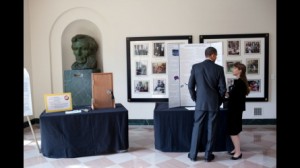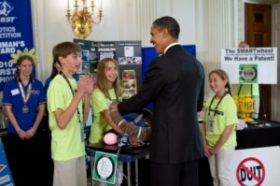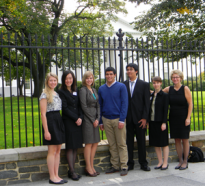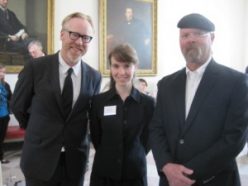Science fair at the White House
Obama invites young scientists to show their stuff
Share this:
- Share via email (Opens in new window) Email
- Click to share on Facebook (Opens in new window) Facebook
- Click to share on X (Opens in new window) X
- Click to share on Pinterest (Opens in new window) Pinterest
- Click to share on Reddit (Opens in new window) Reddit
- Share to Google Classroom (Opens in new window) Google Classroom
- Click to print (Opens in new window) Print
In the fall of 2007, during her freshman year of high school, Raina Jain undertook a science experiment on cell behavior. She could never have guessed that, three years later, she’d be explaining her research to President Barack Obama.

“It was surreal,” Jain says of the big day. “It was an eye-opening and affirmative experience. When you get recognition like this, it motivates you to continue your work.”
Jain, now a senior at Freedom High School in Bethlehem, Penn., won fourth place in the Intel International Science and Engineering Fair, or Intel ISEF, in 2008. Intel ISEF is run by Science News publisher Society for Science & the Public. Jain says she plans to study science — possibly medicine — in college.

“We welcome championship sports teams to the White House to celebrate their victories,” he told the young researchers. “I thought we ought to do the same thing for the winners of science fair and robotic contests, and math competitions.”
The President’s statement was met with enthusiastic applause.
Erika DeBenedictis, who developed a computer program to help spacecraft navigate the solar system, also attended. Her awards include top prize at the Intel Science Talent Search 2010 (Intel STS). She is now a first-year student at the California Institute of Technology who plans to major in physics. DeBenedictis says she is impressed by the President’s dedication to science education programs, and she thought he genuinely enjoyed himself as he talked to the students.
“This really seemed like his idea,” she says. “He was really relaxed and was having fun with having kids at the White House.”
And what does the President look like up close? “He was definitely taller than I thought,” says DeBenedictis, who is five feet, two inches.

Jackson, Jain and DeBenedictis were among eight past winners of SSP education programs. Other alumni of SSP programs who visited the White House include Betlihem Ayalew, Amy Chyao, Eric Delgado, Nicholas Rajen, and Laurie Rumker. The event coincided with the USA Science & Engineering Fair, a two-week program of science activities in the nation’s capital.
The work on display showed “a delightful range of kinds of science,” says SSP President Elizabeth Marincola, who joined the students at the event. She says events like this fair demonstrate the President’s natural curiosity.
“It doesn’t matter that science isn’t his professional field,” Marincola says. “I think anybody who follows this President understands that he’s really an intellectual.”
Notable attendees at the White House Science Fair included Nobel Laureate and U.S. Secretary of Energy Steven Chu, and the President’s science adviser, John Holdren. The students also hobnobbed with Bill Nye the Science Guy and Jamie Hyneman and Adam Savage from “MythBusters.”

How do you get to join these young researchers? DeBenedictis encourages budding scientists to follow their natural curiosity and pick interesting topics. “Don’t wait for a teacher to teach you something,” she says. “It’s more fun if you go learn it by yourself. Research [topics] on your own time and in your own way because that’s how you learn best anyway.”
Jain says the honor of meeting the President was unexpected but not unwelcome. “You never go into it for the competition or the prize,” she says. Science fairs are “a way to showcase your work. And sometimes people get lucky and you get the opportunity to be recognized for what you’ve done.”